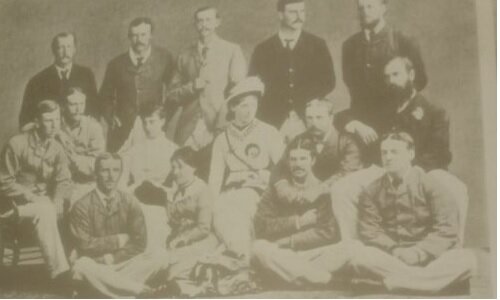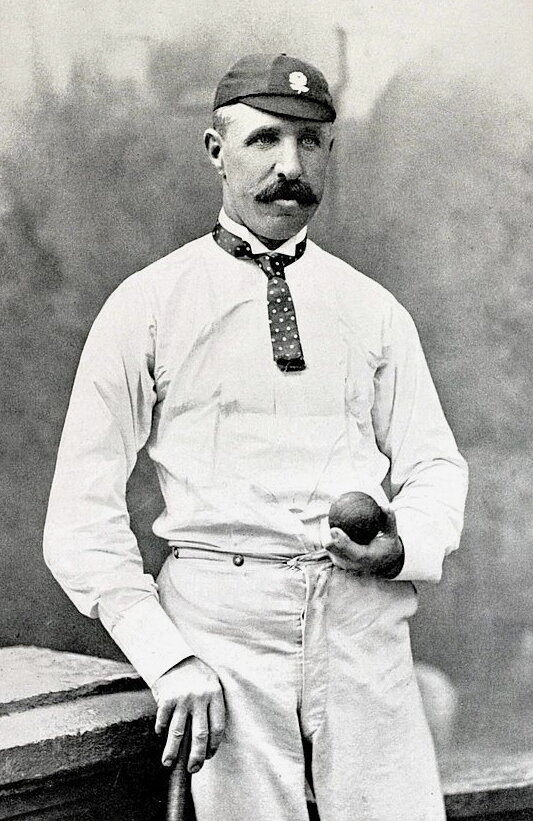The famed Spy caricature of Spofforth
January 2, 1879. Fred ‘Demon’ Spofforth captured the first ever Test hat-trick in the third ever Test. Arunabha Sengupta recalls the way the weak England side capitulated to Dave Gregory’s band of 11 men.
Not too many gentlemen around
The success of Australia’s 1878 tour of the Mother Country, especially after the stirring win against MCC at Lord’s, encouraged another visit of England to the Antipodes in late 1878. The commercial allure was almost irresistible and interest was high. Unfortunately, the team that travelled was the weakest of the representative sides to tour Down Under till then.
The major problem was that WG Grace was wading through his medical studies, on his way to becoming known as “The Doctor”. With the diploma examination approaching, he declined the offer to lead the side to Australia. The previous tour had been undertaken by James Lillywhite and his full professional outfit. Now, however, MCC were keen to elevate the stature of Anglo-Australian cricket. As a result, they had invited an important English amateur, Isaac Walker, to assemble a group of gentlemen cricketers to tour the country, But, without WG, this looked a difficult proposition. There were dropouts as well. “Several other amateurs who had undertaken to go were later obliged to cry off,” wrote HS Altham.
Few of the gentlemen were keen to spend days bowling under the tyrannical tropical sun during the course of an Australian summer. Hence professionals George Ulyett and Tom Emmett had to be included. The position of wicketkeeper remained vacant, finally filled by Leland Hone’s rather patchy and part-time glovework. And finally, when one of Walker’s brothers died, the organiser himself pulled out of the tour.
AN ‘Monkey’ Hornby looked a likely candidate for leadership, but ultimately Lord Harris stepped in. This influential peer, later governor of Bombay and a supreme figure in English cricket administration for the next half a century, boarded the ship with his motley crew and reached Adelaide in December 1878.
Regal treatment
Harris carried an imposing aura of pomp around his deportment, which was conspicuous even in those early days as cricketer. One of his ancestors had been the Prime Minister of Great Britain during the time of Napoleon. The Australians dressed up in their best clothes to welcome him, but remained overawed. So much were they caught up in the grandeur of Harris that the traditional welcome dinner had to be cancelled because no caterer seemed grand enough for the occasion.
The England team led by Lord Harris. McKinnon is standing at extreme right. Royle is seated in the front row second from right.
The team was regally entertained, but the cricket they played failed to do justice to the profound hospitality. They played a few tour matches with moderate success, winning against the weaker and struggling against the moderately strong. All the while arrangements were made for them to take on Dave Gregory’s travelling eleven in two big matches.
Later given the status of a representative team, Gregory’s eleven was actually a band of men who travelled around the colonies playing against the local sides. Yet, the first big match they played against the Englishmen at Melbourne was later considered the third Test match ever played. And the second became the first-ever Test match to be cancelled because of riots linked to betting.
The hat-trick
The first morning at Melbourne started with the toss followed by a thundershower. Yet, unbridled enthusiasm saw 7,000 spectators flocking to the ground during the course of the day. His Excellency the Governor, and Lady Bowen attended the game and Lady Harris was among the many who watched the proceedings.
England won the toss and chose to take first strike and before the openers could emerge on the ground with their bats, a strong downpour interrupted the action. When finally the innings commenced, Fred Spofforth found the wicket to his liking. “The Demon”, who had destroyed MCC in 1878, seemed to be at his most diabolical best.
George Ulyett played on off the second ball. At seven, Frank Allan — bowling from the other end — castled Alexander Webbe.
At 10, Bunny Lucas also had his stumps disturbed by Allan.
Tom Emmett, circa 1895. Because of being a professional, this excellent cricketer is not there in the group photograph. He was Spofforth’s hattrick victim
Four runs later, Spofforth broke one back past Monkey Hornby’s famed bat to hit timber.
At 26, Spofforth whisked one past Reverend Vernon Royle, thereby rearranging his wicket. The man of cloth, ambidextrous and an excellent fielder, was all at sea against bowling of this quality.
Francis Mackinnon, the Mackinnon of Mackinnon, was the 35th chief of the clan of Mackinnon. The curious title made him an amateur. But he was hardly a batsman suited for this level of cricket. He had no answer to “The Demon” as his stumps were flattened first ball.
Tom Emmett broke the monotony of six bowled dismissals by swiping Spofforth down the throat of long stop Tom Horan off the first ball he faced. Spofforth had taken three in three, a pioneering feat that would go down as the first ever hat-trick in Test cricket. The score stood at 26 for 7.
Charlie Absolom, a Kent cricketer of repute and a beard to match WG strand for strand, now proceeded to strike the ball with force and pluck. Harris stood admirably at the other end and the two added 63 for the eighth wicket. Tom Garret bowled his lordship for 33, but Absolom continued to hit hard and handsomely for 52 before Harry Boyle had him superbly caught in the outfield by Alec Bannerman.
Spofforth came back to induce an edge off makeshift stumper Leland Hone. The England line-up, full of glaring holes, were all out for 113. Seven of the 10 were bowled. Lord Harris blamed it on the light and poor weather. Exactly how well a lower middle order of Royle, McKinnon and Emmett could have performed in excellent light is debatable.
What followed
Alec Bannerman, dropped by Hone before he had made a run, top scored with 72. Australia, benefitting from some quixotic bowling changes, piled up 256. Absolom, a crafty slow-medium bowler with over 250 wickets in First-Class cricket, was not given the ball at all during the innings while seven bowlers were used. Emmett picked up seven for 68, but it did not stop Australia from taking a huge lead. Catches were dropped by the dozen. In a letter back home one English cricketer wrote: “I can only account for it in the strong light here, the sky being so deep a blue that it dazzles our eyes, and you cannot judge a catch at all.”
Spofforth once again skittled out seven men as England fell for 160 in the second innings. Eighteen runs were required to be scored and Charles Bannerman and Billy Murdoch made them without fuss.
The early finish on the third day led to an impromptu second match between an MCC XI and a New Zealand team from Canterbury.
Brief scores:
England 113 (Charlie Absolom 52; Fred Spofforth 6 for 48) and 160 (Fred Spofforth 7 for 62) lost to Australia 256 (Alec Bannerman 73; Tom Emmett 7 for 68) and 19 for no loss by 10 wickets.




